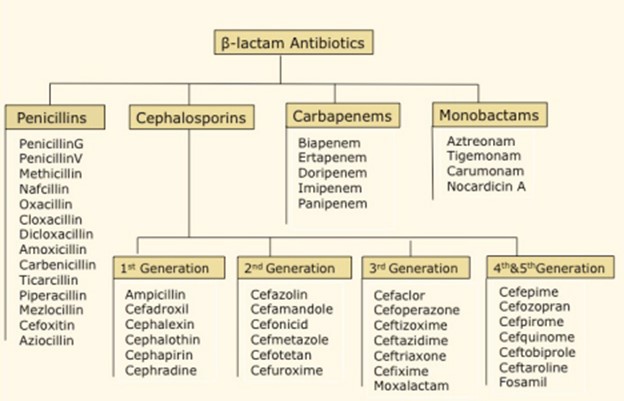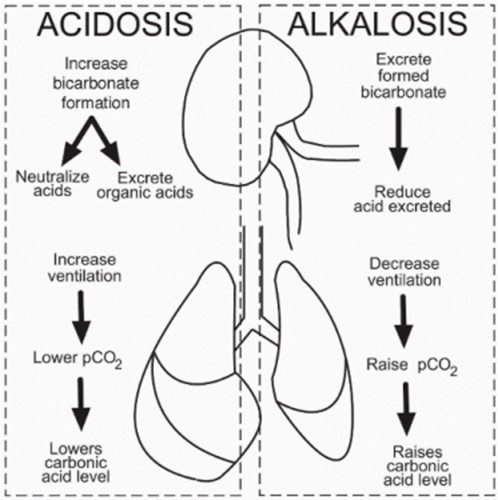Cephalosporins are similar to another group of beta-lactam antibiotics called the?
Macrolides
Fluoroquinolones
Aminoglycosides
Penicillins
The Correct Answer is D
Cephalosporins are similar to another group of beta-lactam antibiotics called the Penicillins. Both cephalosporins and penicillins belong to the beta-lactam class of antibiotics, which share a similar structure and mechanism of action. They inhibit bacterial cell wall synthesis by binding to specific proteins called penicillin-binding proteins (PBPs), leading to bacterial cell death. This shared mechanism of action makes cephalosporins and penicillins similar in their antibacterial effects.
On the other hand, macrolides, fluoroquinolones, and aminoglycosides are different classes of antibiotics with distinct structures and mechanisms of action. They work through different mechanisms to inhibit bacterial growth and have different spectrums of activity compared to beta-lactam antibiotics like cephalosporins and penicillins.

Nursing Test Bank
Naxlex Comprehensive Predictor Exams
Related Questions
Correct Answer is D
Explanation
Mrs. Kalen is diagnosed with gastroenteritis and dehydration, and the arterial blood gas results indicate metabolic alkalosis (elevated pH and HCO3-). This suggests that there is an excessive loss of gastric acid and chloride ions from vomiting, leading to an imbalance of electrolytes and an increase in bicarbonate levels.
To correct the imbalance and treat dehydration, the primary intervention is fluid replacement. Administration of IV 0.9 Saline Solution, also known as normal saline, is commonly used for fluid resuscitation and rehydration. This isotonic solution helps restore fluid balance and electrolyte levels in the body.
Administration of antiemetics may help control vomiting, but the primary treatment focus in this case is fluid and electrolyte replacement to correct dehydration and the associated metabolic alkalosis.
Administration of diuretics, which increase urine output, would not be appropriate in this case as the patient is already experiencing dehydration.
Electrolyte replacement may be necessary if there are specific electrolyte imbalances identified, but the primary treatment is fluid replacement with IV saline solution.
Having the patient go home and rest without addressing the underlying dehydration and metabolic alkalosis would not be appropriate as it can lead to further complications.
Correct Answer is B
Explanation
Respiratory acidosis is a primary acid-base imbalance that occurs when there is an excess of carbon dioxide (CO2) in the body due to impaired ventilation or inadequate removal of CO2 from the lungs. In this case, Colleen's depressed ventilation, indicated by shallow and slow respirations, can lead to inadequate elimination of CO2 from her body. The excessive CO2 levels can result in an accumulation of carbonic acid (H2CO3) in the blood, leading to an increase in acidity and a decrease in pH.
The profuse bleeding from both ears indicates a potential head injury, which can lead to decreased neurological function and impaired control over the respiratory center in the brain. This can further contribute to depressed ventilation and the development of respiratory acidosis. Metabolic acidosis, characterized by a decrease in bicarbonate (HCO3-) levels or an increase in non-carbonic acids in the blood, is not the primary acid-base imbalance in this case since the scenario does not provide information indicating a primary metabolic disorder. Respiratory alkalosis, characterized by decreased levels of CO2 in the blood, leading to increased pH and alkalinity, is not the primary acid-base imbalance in this case. The depressed ventilation and associated increase in CO2 levels indicate the opposite, respiratory acidosis. Metabolic alkalosis, characterized by an increase in bicarbonate levels or a decrease in non-carbonic acids, is not the primary acid-base imbalance in this case as the scenario does not provide information indicating a primary metabolic disorder.

Whether you are a student looking to ace your exams or a practicing nurse seeking to enhance your expertise , our nursing education contents will empower you with the confidence and competence to make a difference in the lives of patients and become a respected leader in the healthcare field.
Visit Naxlex, invest in your future and unlock endless possibilities with our unparalleled nursing education contents today
Report Wrong Answer on the Current Question
Do you disagree with the answer? If yes, what is your expected answer? Explain.
Kindly be descriptive with the issue you are facing.
